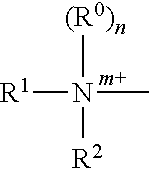Transcription factor decoys for the treatment and prevention of infections caused by bacteria including clostridium difficile
a transcription factor and bacteria technology, applied in chemical libraries, combinational chemistry, sugar derivatives, etc., can solve the problem of little gene conservation between i>c. difficile and achieve the effect of reducing the amount of labelled
- Summary
- Abstract
- Description
- Claims
- Application Information
AI Technical Summary
Benefits of technology
Problems solved by technology
Method used
Image
Examples
example 1
Spo0A TFD Blocks Sporulation of C. difficile
[0325]TFDs were designed to block the binding of the transcription factor Spo0A that induces sporulation in C. difficile. The TFDs were assembled into nanoparticles capable of carrying the TFD into the cytoplasm of C. difficile, where the TFD binds to and competitively inhibits the action of Spo0A. Hence, when the nanoparticles were mixed with Spo0A TFD-laden nanoparticles, the number of spores produced was found to be dramatically reduced in comparison to a control sample.
Materials and Methods
Preparation of TFD Dumbbells by Ligation (DB-TFD)
[0326]Two phosphorylated oligonucleotides were synthesised, each containing one strand of the recognition site for the C. difficile Spo0A transcription factor. At either end of the molecule, a small hairpin loop acted to protect the molecule from degradation. Each oligonucleotide was re-suspended in dH2O at a concentration of 250 pmol / μl:
SEQ ID NO: 13-Spo0ADB1:CTT GGT TTT TCC AAG AGC TTG TGT AGA AGG T...
example 2
TcdR TFD to Block Toxin Production
[0335]TFDs were designed to block the binding of the transcription factor TcdR that induces the production of the two Toxins A and B (encoded by tcdAB) in C. difficile. These were assembled into nanoparticles capable of carrying the TFD into the cytoplasm of C. difficile, where they would bind to and competitively inhibit the action of TcdR. Hence, when the nanoparticles were mixed with TcdR TFD-laden nanoparticles, the relative amount of Toxins produced was found to be dramatically reduced in comparison to a control sample.
Materials and Methods
Preparation of TFD Dumbbells by Ligation (DB-TFD)
[0336]Two phosphorylated oligonucleotides were synthesised, each containing one strand of the recognition site for the C. difficile TcdR transcription factor, and ligated to form the TFD dumbbell:
SEQ ID NO: 15-TcdRDB1:CTT GGT TTT TCC AAG AAG TTT ACA AAA TTA TATTAG AAT AAC TTT TTA TTSEQ ID NO: 16-TcdRDB2:CCC TCT TTT TGA GGG AAT AAA AAG TTA TTC TAATAT AAT TTT GTA...
example 3
FapR TFD Prevents C. difficile Growth In Vitro
[0343]TFDs were designed to block the binding of a transcription factor, FapR, which is significantly induced on damage to C. difficile walls by antibiotics such as amoxicillin. FapR was targeted because it was hypothesised that treatment with nanoparticles would also damage the cell wall and induce similar pathways. The function of the transcription factor was to control enzymes involved in fatty acid metabolism, themselves key for repair to the cell wall.
Materials and Methods
Preparation of TFD Dumbbells by Ligation (DB-TFD)
[0344]Two phosphorylated oligonucleotides were synthesised, each containing one strand of the recognition site for the C. difficile FapR transcription factor, and ligated to form the TFD dumbbell:
SEQ ID NO: 17-FapRDB1:CTT GGT TTT TCC AAG TAG AAT TAG TAC CTG ATACTA ATA ATTSEQ ID NO: 18-FapRDB2:GCC TCT TTT TGA GGC AAT TAT TAG TAT CAG GTACTA ATT CTA
[0345]These were annealed, ligated and concentrated as described in Exam...
PUM
| Property | Measurement | Unit |
|---|---|---|
| Fraction | aaaaa | aaaaa |
| Electrical resistance | aaaaa | aaaaa |
| Antimicrobial properties | aaaaa | aaaaa |
Abstract
Description
Claims
Application Information
 Login to View More
Login to View More - R&D
- Intellectual Property
- Life Sciences
- Materials
- Tech Scout
- Unparalleled Data Quality
- Higher Quality Content
- 60% Fewer Hallucinations
Browse by: Latest US Patents, China's latest patents, Technical Efficacy Thesaurus, Application Domain, Technology Topic, Popular Technical Reports.
© 2025 PatSnap. All rights reserved.Legal|Privacy policy|Modern Slavery Act Transparency Statement|Sitemap|About US| Contact US: help@patsnap.com



